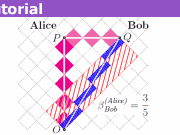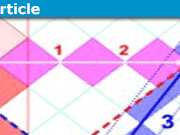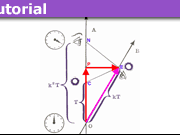Learn About Tetrad Fields and Spacetime
A spacetime is often described in terms of a tetrad field, that is, by giving a set of basis vectors at each point. Let the vectors of the tetrad be denoted by eaμ, where μ is a tensor index and where a is a tetrad index that serves to number the vectors from 1 to 4.
The inner prioducts of the vectors, eaμ ebμ = ηab, are assumed to be constants given a priori. For orthonormal tetrad fields, ηab is just the Minkowski matrix, Diag(1, -1, -1, -1). We may also use its inverse matrix to define quantities ηab = (ηab)-1. The fact that the vectors are linearly independent is expressed by the completeness relation gμν = eaμ ebν ηab.
Then the following convention is natural and convenient: gμν, eaμ and ηab are all “fundamental” tensors, that is, tensors whose application does not change the object itself, but only the nature of an index. Just as gμν raises and lowers indices and changes them from contravariant to covariant and vice versa, ηab is used to raise and lower tetrad indices, while eaμ can be used to change an index from a tensor index to a tetrad one and vice versa. Thus
Tμν
Taν = eaμ Tμν
Tμb = ebν Tμν
Tab = eaμ ebν Tμν
are understood to be manifestations of the “same” tensor T. Thanks to orthonormality and completeness we may convert back and forth between the different descriptions without any loss of information. In what follows, we will freely make use of this property without explicitly calling attention to it.
The processes of changing from a tensor index to a tetrad index and back have been called “strangulation” and “resurrection” respectively.
Table of Contents
Derivatives
Associated with tetrad fields are several different types of derivative.
1) The Covariant Derivative
A semicolon will be used to denote the usual covariant derivative which ignores tetrad indices, and for example treats eaμ as simply a set of vectors.
Define
Aμaν = eaμ;ν
This field is known as the Ricci rotation coefficient. It plays a central role in what follows. The strangled components Abaν are antisymmetric in a and b, since
Abaν = ebμ eaμ;ν = (ebμ eaμ);ν – ebμ;ν eaμ = ηab;ν – eaμ ebμ;ν = – Aabν
Our convention automatically guarantees that the unstrangled components of an object have the same symmetry properties as the strangled ones. Therefore Aμνσ is also antisymmetric in μ and ν. Furthermore, any tensor Aμνσ antisymmetric in μ and ν satisfies identically
Aμνσ = Aμ[νσ] + Aν[σμ] + Aσ[νμ]
The importance of this is that Aμ[νσ] = ebμ eb[ν,σ] involves only partial derivatives, indicating that the Ricci rotation coefficients may be calculated directly without knowledge of the Christoffel symbols.
To get an intuitive feel for the Ricci rotation coefficients, let us calculate the change in the tetrad under an infinitesimal displacement. Since orthonormality is perserved, this change can only be a Lorentz rotation, Ωab
δeaμ = Ωab ebμ = eaμ;ν δxν
showing that Ωab = Abaν δxν. Thus Abaν measures the rotation of the tetrad in the ab plane when we make a small step in the ν direction.
2) The Intrinsic Derivative
The intrinsic derivative of any quantity with respect to a given tetrad, denoted by a stroke, is obtained by strangling completely, taking the covariant derivative of the resulting scalar (or equivalently its partial derivative), and then resurrecting. For example,
Taμ|ν = (Taσ ebσ);ν ebμ
According to this definition, intrinsic differentiation commutes with strangulation and resurrection. Equivalently, ebμ|ν = 0. For example:
ebμ Taμ|ν = Tab|ν
With the help of the Ricci rotation coefficient we can write the relationship between the intrinsic derivative and the covariant derivative, with a correction term appearing for each tensor index. For example:
Taμ|ν = Taμ;ν + Taσ Aσμν
3) The Invariant Derivative
The third type of derivative is the invariant derivative, denoted by a dot, in which we first resurrect any tetrad indices that might be present, take the covariant derivative, then strangle back again. That is,
Taμ.ν = (Tbμ ebσ);ν eaσ
As before, invariant differentiation commutes with strangulation, and equivalently eaμ.ν = 0. For an object with only tensor indices, the invariant derivative is identical to its covariant derivative. For this reason the invariant derivative is the natural generalization of the covariant derivative to tetrad analysis. The relationship between the covariant and invariant derivative can be written using the Ricci rotation coefficient:
Taμ.ν = Taμ;ν – Tbμ Abaν
with a similar term required for each tetrad index.
The Riemann Tensor
For any vector T,
Ta.ν = Ta;ν – Tb Abaν
Ta.νσ = Ta;νσ – Tb;ν Abaσ – Tb;σ Abaν – Tb Abaν.σ
Antisymmetrizing on ν and σ, the first three terms drop out:
Ta.[νσ] = – Tb Aba[ν.σ]
By comparison,
Ta.[νσ] = (Tμ eaμ).[νσ] = eaμ Tμ;[νσ] = -1/2 eaμ Tτ Rτμνσ = -1/2 Tb Rbaνσ
Since this must hold identically for all T, we have a simple expression for the Riemann tensor:
Rτμνσ = 2 Aτμ[ν.σ]
— This article was originally part of Physics Forums member Bill_K‘s PF blog. He may not respond to comments.
Next up:
William Kinnersley earned his Ph.D. from Caltech in 1968, under the direction of Kip Thorne.







Would writing "tetrad indices" with a distinguishing mark, such as a hat, for instance ##T_{hat{a}hat{b}}## be reasonably standard notation, or would it have unwanted implications, such as the ##e_a## being orthonormal? I found myself mentally adding the hats when reading your insight article just to follow it. Interestingly enough, I don't think I've ever seen ##e_a{}^b## written as ##e_hat{a}{}^b##, though that would perhaps be more consistent notation.